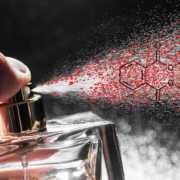Side Effects of Chemical Perfumes
Perfumes have historically been used for distinctive pleasant smells that make us feel relaxed and rejuvenated. But the side effects of chemical perfumes have become a major concern nowadays since the vast majority of perfumes are made from hazardous chemicals. Therefore, they are found to be associated with various health complications ranging from asthma to skin allergies to even cancer.
In this article, we’ll be exploring some of the most common side effects of chemical perfumes on human health as well as the environment. But first, we’ll need to know exactly what chemical perfumes are. So, let’s get started.
Table of contents
-
What are chemical perfumes?
-
What chemicals are in perfumes?
-
Side effects of chemical perfumes
-
Effects of chemical perfumes on the body
-
Side effects of perfumes on skin
-
Effects of chemical perfumes on the environment
-
What perfumes are not harmful?
-
Frequently asked questions (FAQs)
What are chemical perfumes?
Chemical perfumes refer to synthetic scents created from unidentified mixtures of artificial chemicals. These synthetic chemicals might act as allergens, endocrine disruptors, respiratory irritants, environmental toxicants, neurotoxic agents, and even cancer-causing agents or carcinogens. But the problem is that these ingredients are not fully disclosed on the label and are kept tactfully hidden under the term “fragrance” or “parfum”.
What chemicals are in perfumes?
More than 3000 chemical compounds, including both natural and synthetic, are used to compose perfumes or other fragrance materials. In general, a perfume composition may hold onto from ten to more than three hundred different chemicals.
Drawing scents from nature has a long history in perfumery for health and religious purposes. In the late 1800s, man-made chemicals started emerging in the perfume industry only because they are far cheaper than natural ones. Unfortunately, today the overwhelming majority of perfume ingredients are man-made, synthetic, or artificial chemicals, while natural chemicals are very limited and rare, making perfume lovers highly susceptible to getting sick.
Man-made chemicals used as perfume ingredients are potentially hazardous to human health and the environment. Let’s take a look at some of the common harmful chemicals and their possible activities in the body:
Dangerous chemicals in perfumes
Synthetic musks – This group of chemicals includes various types such as musk ketone, musk xylene, galaxolide, and tonalide. These chemicals have been linked to disruption to the reproductive system, development, and hormone balance and may also cause organ damage.
Diethyl phthalate (DEP) – phthalates may cause damage to the nervous system and are considered a potential hormone disruptor. It also acts as a respiratory tract, skin, and eye irritant.
Methylene chloride (dichloromethane) – Animal studies have shown increases in liver and lung cancer and benign mammary gland tumors following the inhalation of dichloromethane. U.S. EPA has classified dichloromethane as a probable human carcinogen.
Methyl chloride (chloromethane) – This chemical negatively impacts the skin, kidneys, and liver and also affects the nervous system.
Butylphenyl Methylpropional – it triggers itchiness and skin inflammation.
Styrene – This chemical is reasonably known to be toxic to the liver and erythrocytes or RBCs (red blood cells).
Dioxane – potentially carcinogenic to humans.
Titanium dioxide (TIO2) – possibly carcinogenic to human cells. Also may cause damage to the lung and respiratory system.
Resorcinol – This chemical has a negative impact on the nervous and cardiovascular systems. May alter kidney, liver, and spleen functioning.
Propylparaben – this chemical has been linked to breast cancer.
Oxybenzone (BP-3) – it accumulates in the liver, kidneys, and blood. Might have toxic effects on the liver cells.
Formaldehyde – a proven carcinogen to humans.
Butoxyethanol – a known throat, nose, eye, and skin irritant. Excess exposure may lead to long-term damage to the liver, blood cells, kidneys, respiratory system, nervous system, and lymphoid system.
Benzyl benzoate – exposure may irritate and burn the scalp and genitalia.
Benzyl salicylate – a known allergen that may cause skin and eye irritation.
Butylated hydroxytoluene (BHT) – this molecule is known as an eye and skin irritant.
Butylated hydroxyanisole (BHA) – This is listed to be an endocrine disruptor and carcinogen in humans.
Benzophenone – an endocrine disruptor that has been linked to developing tumors in liver cells.
Acetaldehyde – This chemical adversely affects the respiratory and nervous systems and kidneys and also is considered possibly carcinogenic to humans.
Side effects of chemical perfumes
Exposure to chemical perfumes may cause a wide range of varying adverse effects on the human body ranging from migraine headaches to respiratory difficulties to skin irritations. Man-made chemical compounds found in chemical perfumes have detrimental effects not only on the human body but also on the environment and other animals as well.
Let’s have a look at some of the most prevalent detrimental effects of chemical perfumes on the body:
Effects of chemical perfumes on the body
Synthetic or chemical perfumes have been linked to many different detrimental effects on the body, including, but not limited to:
Headaches – Headaches are a common problem often found associated with chemical perfumes, especially on direct inhalation or exposure to perfume mixture. In addition, an intense headache may lead to nausea, vomiting, and dizziness as well. People who have chronic headaches or migraines are more susceptible than others.
Birth defects (child autism and others) – Although the dangers of synthetic chemicals used in perfumes can affect everyone, they could be even more serious in children, pregnant women, and developing fetuses. Nearly an estimated 95% of perfume chemicals are petrochemicals. Not only in perfumes but also they are used in almost every personal care product including hair sprays, soaps, and shampoos.
One of the most prevalent petrochemicals used in perfumes is phthalates. Fetal exposure to this class of chemicals has been linked to various birth defects such as autism, neurological disorders, and symptoms of attention deficit hyperactivity disorder (ADHD).
Asthma, lung disease, and other breathing difficulties – the man-made chemicals used in perfumes are volatile and are most often breathed in to feel the pleasant smells. This may lead to various issues in the respiratory system ranging from infections of the lungs to damaging lung cells. Artificial chemicals act as enemies of optimal breathing and worsen symptoms of asthma and other breathing problems upon being exposed to them.
Harm to the reproductive system – Synthetic chemicals widely used in perfumes such as parabens and phthalates may travel through the reproductive system and disrupt the functionality of reproductive hormones. This may affect the development, maintenance, and function of reproductive organs and sometimes even may lead to infertility.
Cancer – The most alarming concern of exposure to chemical perfumes is the risk of developing various types of cancer. Certain synthetic chemicals have the capacity to accumulate in fatty tissues in the human body. Some are also found present in breast milk as well.
Some synthetic chemicals seem to be highly toxic and have hormone-disrupting effects on the human body that may lead to a risk of organ failure and cancer, especially those induced by hormone imbalances. A large number of synthetic chemicals used in perfumes, such as styrene, parabens, synthetic musks, and phthalates, just to name a few, seem to have carcinogenic effects on the human body.
Toxic bodily reactions and allergies – man-made synthetic chemicals used in perfumes or fragrances have been found to produce a range of toxic effects in the body. They may cause several combinations of nose, eye, and throat irritations, symptoms of neurotoxicity, pulmonary irritation, and reduction in airflow velocity during exhaling.
Besides, hazardous chemicals used in perfumes and other fragrant products are considered one of the most prevalent allergens affecting nearly each and every person throughout the world. They may cause a wide range of allergic reactions including sinus irritation, swelling, difficulty breathing, migraine headaches, and various types of skin reactions such as contact dermatitis.
Let’s take a look at some common side effects of chemical perfumes on the skin separately:
Side effects of perfumes on skin
The skin is supposed to be the most sensitive to perfumes, more specifically to perfume chemicals. Side effects of perfumes on the skin may result from both ways – inhalation and direct contact. Exposure to chemical perfumes may cause a variety of detrimental effects on the skin, including:
Contact dermatitis – it’s a category of skin rash. It occurs on the skin when the skin comes into direct contact with chemicals that have the potential to cause irritation or allergic reactions. Depending on the causative compounds, contact dermatitis could be of two types –
- Irritant contact dermatitis – it’s occurred upon repeated exposure over a long period of time to chemicals that have mild irritant effects on the skin.
- Allergic contact dermatitis – occurs when certain chemicals act as allergens, meaning the skin becomes sensitive to specific chemicals with previous exposure and comes in contact again with the same chemicals that are identified as allergens by the body and treated as so.
Urticaria – It’s a type of skin hive or rash that is characterized by raised, skin-colored, or red welts on the surface of the skin with intense itchiness and sometimes absurd swelling.
Dyschromia – It’s a type of irregular and patchy discoloration of the skin, also known as mottling or mottled skin. It occurs when chemicals or foreign substances cause vascular changes in skin blood vessels, resulting in changes in the concentrations of melanin, the pigment that gives the skin its color.
Effects of chemical perfumes on the environment
The harmful chemicals used in perfumes and fragrances adversely affect not only humans but also the environment and other animals too. They can contaminate the environment in many different ways, especially through water and air pollution.
When volatile chemicals are released into the air, they react with thousands of other airborne environmental particles such as pollutants and industrial chemicals and eventually form a new variant of a component that is literally more lethal than the previous ones. These particles sink into the lakes, rivers, and oceans where they harm millions of other animals.
Unfortunately, even modern techniques of filtration fail to remove such particles completely from the waterbodies. As a result, they return and circulate to our water system, and afterward, we consume them.
What perfumes are not harmful?
Natural perfumes, essential oils, and pure attars originating from natural flora and fauna such as flowers, roots, barks, leaves, spices, and various animal pheromones are generally safe and non-toxic to humans.
While synthetic molecules are found to cause illness, natural perfumes are found to have noticeable healing effects on the human body that can help with many health conditions ranging from physical to mental to emotional health. This is the reason why we should consider switching to natural perfumes from chemical ones that are of natural origins and do not contain any synthetic chemicals (please see our Guaranty of naturality).
Frequently Asked Questions (FAQs)
Can perfumes cause health problems?
Mass-produced perfumes may contain synthetic chemicals that are hazardous to human health and exposure to which may lead to a range of health problems including allergies, lung disease, organ damage, and even cancer.
What toxic chemicals are in perfumes?
There are more than 100 toxic ingredients used in industrial perfumes and fragrances. The most common ones may include styrene, phthalates, synthetic musks, and parabens, just to name a few.
Can perfumes harm your lungs?
Chemicals used in perfumes are volatile. In order to feel the pleasant smells, we often breathe in them. When inhaled, certain toxic man-made chemicals may lead to triggering various lung conditions ranging from allergies to infections. They either settle down inside the lungs and cause damage to lung tissues or travel through other bodily systems, leading to undoable damage in the body.
Why some perfumes cause headaches
Chemicals in perfumes may stimulate or cause inflammation in specific brain nerves such as the trigeminal nerve, which may result in migraines. Furthermore, some chemicals may lead to rapid dilation and constriction of blood vessels in the brain, resulting in throbbing pain or headaches.
Does perfume go into your bloodstream?
Certain perfume chemicals, especially those that are toxic in nature, may pass through the lungs or skin and go into the bloodstream, which may disrupt many bodily systems such as the immune and hormone systems.
Disclaimer: This article has been written for informational and educational purposes only and the data and information provided have not been peer-reviewed by any medical organizations or environmental groups. Therefore, more research is needed to confirm the data and information available here.
Check out our Guarantee of Naturality manufacturing policies and our Natural Perfumes that don’t contain any synthetic materials often the cause of allergic reactions.
SEE ALSO:
Why phthalates in perfumes are dangerous?
Perfume allergy – Symptoms, causes and cure
Scent of Danger: Are There Toxic Ingredients in Perfumes and Colognes? (from Scientific American)

























Leave a Reply
Want to join the discussion?Feel free to contribute!